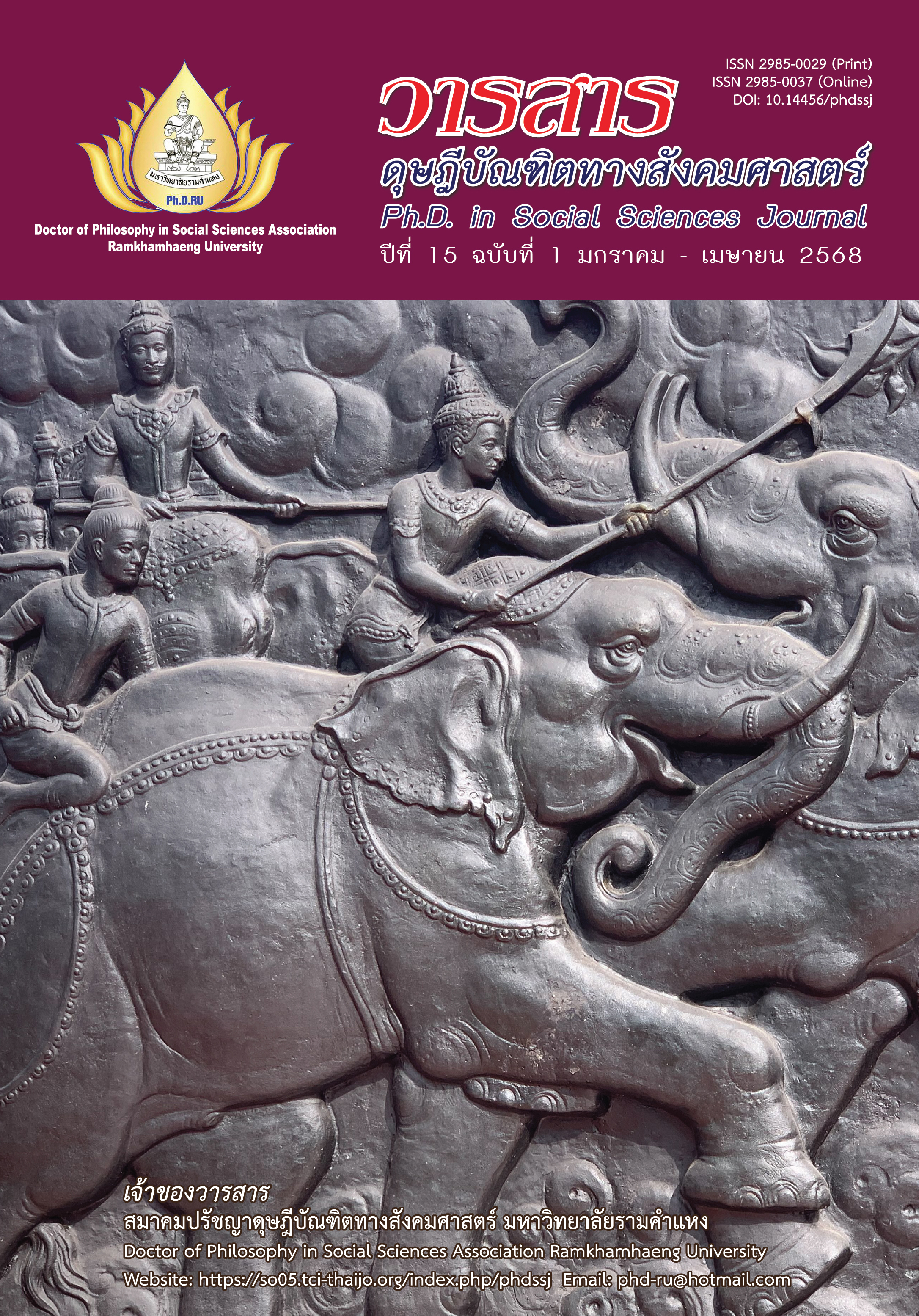Management Accounting Strategies with Business Efficiency
Main Article Content
Abstract
This academic article aims to study management accounting strategies with business efficiency. Using the Contingency Theory by Fiedler (1967) and the Situational management concept of Akdoğan and Cingöz (2012) stated that businesses must accept changes in circumstances and adapt to those changes. However, changes in circumstances determine the growth and survival of an organization.
Findings are as follows: Management accounting strategies with business efficiency,
together with (1) The situation determines the style of management. (2) Choosing a management style that is appropriate to the situation. (3) Strategic planning affects the discovery of new business opportunities and awareness of upcoming risks. The management style starts with planning and ends with control, which brings competitive advantages to the business. That means business efficiency.
Article Details

This work is licensed under a Creative Commons Attribution-NonCommercial-NoDerivatives 4.0 International License.
Academic articles, research articles, and book reviews in the Ph.D. in Social Sciences Journal are author’s opinions, and not the publisher’s, and is not the responsibility of the Ph.D. in Social Sciences Journal Philosophy Association, Ramkhamhaeng University. (In the case that research is done on human, the researcher has to be trained in Ethics for Doing Research on Human Training and has to produce the evidence of the training).
References
Abdel-Maksoud, A., Abdallah, W., & Youssef, M. (2012). An empirical study of the influence of intensity of competition on the deployment of contemporary management accounting practices and managerial techniques in Egyptian firms. Journal of Economic and Administrative Sciences, 28(2), 84-97.
Abernethy, M. A., Bouwens, J., & Van Lent, L. (2010). Leadership and control system design. Management Accounting Research, 21(1), 2-16.
Ahmad, K., & Mohamed Zabri, S. (2015). Factors explaining the use of management accounting practices in Malaysian medium-sized firms. Journal of Small Business and Enterprise Development, 22(4), 762-781.
Ahmeti, S., Sahiti, A., & Ahmeti, Y. (2013). Application of target cost and its impact on the businesses. Anglisticum Journal of the Association-Institute for English Language and American Studies, 2(4), 275-280.
Ahn, J., Mortara, L., & Minshall, T. (2013). Linkages between CEO characteristics and open innovation adoption in innovative manufacturing SMEs. Retrieved from http://ssrn.com/abstract=2328644
Akdoğan, A. A., & Cingöz, A. (2012). An empirical study on determining the attitudes of small and medium sized businesses (SMEs) related to coopetition. Procedia–Social and Behavioral Sciences, 58, 252-258.
Boons, A. N. A. M. (1998). Product costing for complex manufacturing systems. International Journal of Production Economics, 55(3), 241-255.
Cadez, S., & Guilding, C. (2008). An exploratory investigation of an integrated contingency model of strategic management accounting. Accounting, Organizations and Society, 33(7-8), 836-863.
Carroll, A. B., & Shabana, K. M. (2010). The business case for corporate social responsibility: A review of concepts, research and practice. International Journal of Management Reviews, 12(1), 85-105.
Certo, S. C. (2000). Modern management. Prentice Hall.
Chenhall, R. H., & Langfield-Smith, K. (1998). Adoption and benefits of management accounting practices: An Australian. Management Accounting Research, 9(1), 1-19.
Chong, V. K., & Chong, K. M. (1997). Strategic choices, environmental uncertainty and SBU performance: A note on the intervening role of management accounting systems. Accounting and Business Research, 27(4), 268-276.
Cooper, R., & Slagmulder, R. (2000). Activity-based budgeting--part 1. Strategic Finance, 82(3), 85-86.
Emerson, H. (1913). The twelve principles of efficiency. The Engineering Magazine.
Farjoun, M. (2002). Towards an organic perspective on strategy. Strategic Management Journal, 23(7), 561-594.
Fiedler, F. E. (1967). A theory of leadership effectiveness. McGraw-Hill.
Freeman, R. E. (1984). Strategic management: A stakeholder approach. Pitman.
Gordon, L. A., & Miller, D. (1976). A contingency framework for the design of accounting information systems. Accounting, Organizations and Society, 1(1), 59-69.
Gordon, L. A., & Narayanan, V. K. (1984). Management accounting systems, perceived environmental uncertainty and organization structure: An empirical investigation. Accounting, Organizations and Society, 9(1), 33-47.
Govindarajan, V. (1984). Appropriateness of accounting data in performance evaluation: An empirical examination of environmental uncertainty as an intervening variable. Accounting, Organizations and Society, 9(2), 125-135.
Hambrick, D. C., & Mason, P. A. (1984). Upper echelons: The organization as a reflection of its top managers. The Academy of Management Review, 9(2), 193-206.
Hunger, J. D., & Wheelen, T. L. (2003). Essentials of strategic management (3rd ed.). Prentice Hall.
Jensen, M. C., & Meckling, W. H. (1976). Theory of the firm: Managerial behavior, agency costs and ownership structure. Journal of Financial Economics, 3(4), 305-360.
Kaplan, R., & Norton, D. (1996). Linking the balanced scorecard strategy. California Management Review, 39(1), 53-79.
Limbach, P., Schmid, M., & Scholz, M. (2016). All good things come to an end: CEO tenure and firm value. Retrieved from https://www.alexandria.unisg.ch/handle/20.500.14171/104457
Mitchell, F., & Reid, G. C. (2000). Problems, challenges and opportunities: The small business as a setting for management accounting research. Management Accounting Research, 11(4), 385-390.
Nandan, R. (2010). Management accounting needs of SMEs and the role of professional accountants: A renewed research agenda. Journal of Applied Management Accounting Research, 8(1), 65-77.
Netnim, J. (2017). Improvement in the process of inventory management by applying the Kaizen approach case study: Clothes Warehouse Royal Thai Armed Forces Headquarters. National Defence Studies Institute Journal, 8(1), 96-110. [In Thai]
Office of the National Economic and Social Development Council. (2017). The twelfth national economic and social development plan (2017-2021). Author. [In Thai]
Onali, E., Galiakhmetova, R., Molyneux, P., & Torluccio, G. (2016). CEO power, government monitoring, and bank dividends. Journal of Financial Intermediation, 27, 89-117.
Peterson, E., & Plowman, E. G. (1953). Business organization and management. Richard D. Irwin.
Rof, L. M. (2012). Advanced costing methods and their utility in organizing management accounting. The Young Economists Journal, 1(18), 62-69.
Stogdill, R. M. (1974). Handbook of leadership: A survey of theory and research. The Free Press.


